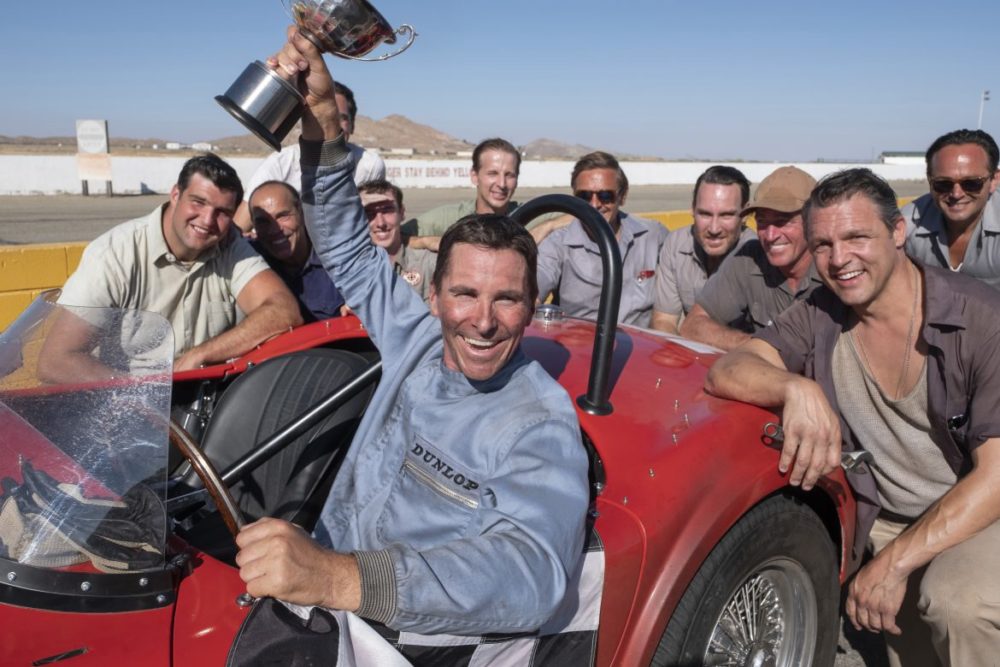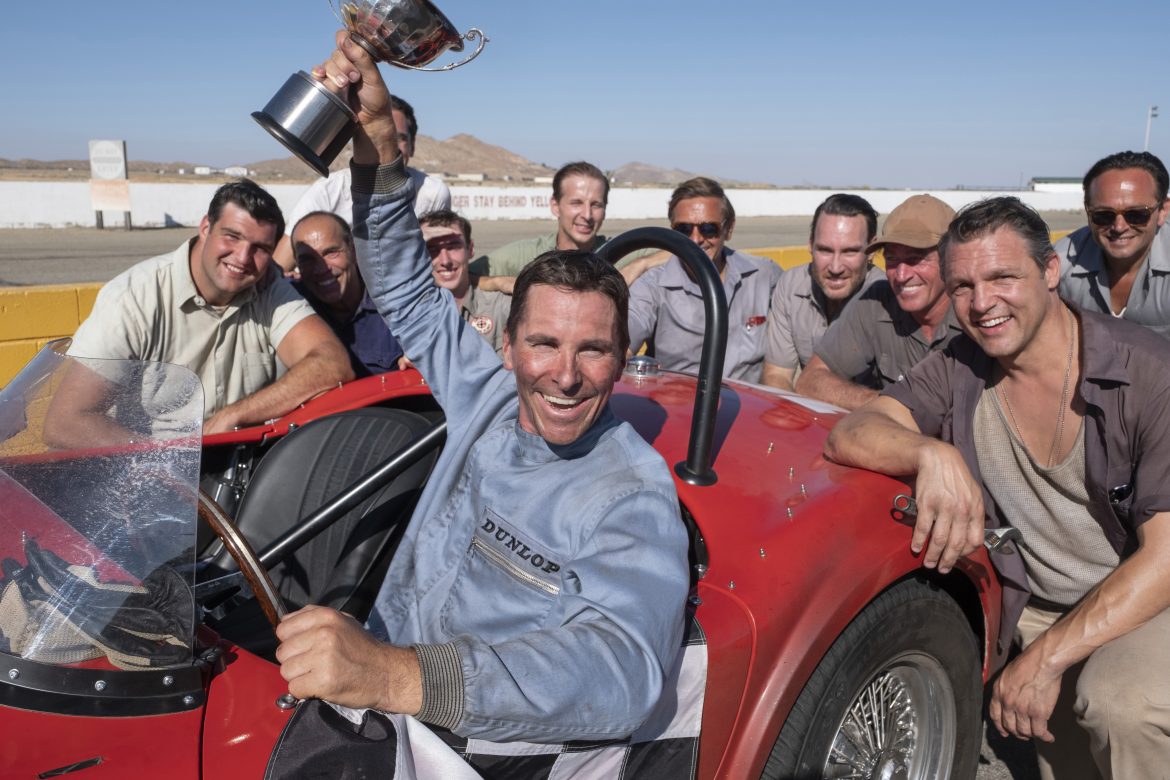PEDAL TO THE METAL
“I wanted to make a movie that helped you feel what it was like to be one of these guys in these rat-trap flying coffins flying around corners at 200mph,” says director James Mangold, director of Le Mans ’66. “It seemed to me that we had to find ways to do it for real.”
The man called in to put the viewer square in the driving seat was Robert Nagle. The stunt coordinator on Baby Driver, Nagle has driven on more than 70 productions, including work on the Fast & Furious and Mission: Impossible franchises, but this was his first time working with Mangold. “He gave us the flexibility to put together some really cool race sequences,” says Nagle, on his collaboration with the director. “We got to sit down and really pencil out a story for each race. We make it look real, make the audience feel they’re part of it.”
The production built more than 30 cars for filming and Nagle would talk through the sequences with the drivers in exhaustive detail. “You know, ‘You’re going to be in this position, you’re going to be in that position…’ So it’s a talking through of the choreography – when and where it all happens on camera,” says Nagle. “At the end of the day, that’s what matters. If we don’t get it on camera there’s no point to it.”
It helped inordinately that Christian Bale – who plays real-life racing ace Ken Miles, the enigmatic driver at the heart of the story – is such a natural racer himself. He and Nagle spent time together training before filming started, including at a driving school run by Bob Bondurant, an old friend of the real Ken Miles. “So, there was a lot of crucial input to get from Bob. Christian would just devour that. He absolutely loved it,” Nagle says.
“Nagle is fantastic,” Bale says in return. ”I’ve hung off the side of a 1930s car, racing through Wisconsin, hanging on by a strap with him. I didn’t want a harness in case the car rolled – I wanted to be able to jump off. Nagle was at the wheel, flying through the middle of the night. It was brilliant. He is brilliant. To get to train with him was brilliant.”
For Nagle, the admiration is mutual. “He is hands down the best actor I have ever trained to drive,” says Nagle. “He’s an amazing, amazing driver. He has an ability to focus himself and push himself. He has the right amount of self-drive to push himself, balanced with the ability to apply what we taught him as he went along. He is truly fantastic.”

ALL THE RIGHT STUFF
Nagle was inspired to get started in the stunt-driving business by the classic street racing sequences in John Frankenheimer’s Ronin – and he wanted to deliver the same sense of immediacy here. You feel every turn, the pace, the danger. The key to capturing the speed was to get close to the action – in and amongst the cars. Equipment was crucial. “There’s an array of different tools for me to utilise,” says Nagle. “My main goal was to make all this look as realistic as possible.” Vital to this was The Biscuit Rig – so named because it came into its own during the horseracing sequences in Seabiscuit. “It allows us to put the actors in the middle of these racing sequences at speed,” explains Nagle. “It’s a rig you can put a vehicle on. Then you put the actor in the vehicle. It’s a self-driven trailer, if you will.” The set-up makes it look as though the actor is driving at all times but allows them to concentrate on performance – while the stunt driver is actually in control. “It’s pretty seamless,” says Nagle. “Because all of the physics are real. It means you can put them right in the middle of the action.”
For cinematographer Phedon Papamichael the key was ensuring that the camera truly captured the speeds the actors were going at. “The most challenging aspect was getting really close to these cars, because when you watch Formula 1 on TV, or NASCAR, they are going 220mph, but it just doesn’t look fast on a long lens panning. The trick is to get close, be wide, get physically close. Track with them. Or break into frame, inches apart!”
Sometimes those inches disappeared completely – and there were collisions. “We had it where the car hit the camera,” explains Papamichael. “But you’ve just got to sometimes. It’s basically a dance between the drivers. It’s like choreography, but it’s tiny margins. If someone missteps a little bit, it’s very dangerous.”
Anyone watching the filming would have had their eye drawn to one particularly peculiar car: known as the ‘Frankenstein Rig’. This was used to follow the action at speed, but in order to capture unique camera angles it was basically a shell. “A frame, so you can mount the cameras on it low,” explains Papamichael. There was also a Porsche Cayenne mounted with an arm to move the camera up and down. The traditional rigs wouldn’t have worked, because of the G-force of the speeds they were going on. “So,” explains Mangold. “You build it!”
“Sometimes we had four or five cameras on at once,” says Papamichael, who along with Nagle points out that the changes in technology mean it is now possible to have up to three cameras inside a car cockpit, whereas previously you’d have struggled to fit one. “You’re searching for this moment, the light, the expression as they go by.”
SAFE WORD
“If anything goes wrong it’s going to go wrong very quickly and very badly,” says Nagle, reflecting on the risks of filming – and his responsibility to ensure everyone survived the quest to shoot as realistically as possible. “It comes down to the professionalism and talent of the drivers involved.” To that end it was crucial to have superb drivers – though he didn’t just want people experienced with stunts, but with racing. “It’s a difference of mindset and technique,” explains Nagle. “Most stunt drivers are very good drivers, but they don’t have the ability to take that corner with the car at 100% of its capability every single time.” So, he set out to get as many professional racing drivers as he could. “I needed everybody’s talent to push the cars to the limits.”
That also led him to people with a personal connection to the story. Three of the drivers on Le Mans ’66 had fathers who had raced at Le Mans themselves. Alex Gurney is the son of multidiscipline racing champion Dan, Derek Hill the son of triple Le Mans champ Phil, Jeff Bucknum the son of Ronnie, a teammate of the legendary Ken Miles at the ’66 race. Nagle was “over the moon” to have them involved. “To me, of course they should be on this! That’s the kind of driver I needed for this film. I didn’t need stunt drivers. I needed professional race drivers. Drivers who understood. So, when I laid out a race sequence, they would understand what I was talking about.”
All three drivers reflect on the detail and excitement of the shoot – including racing down the recreation of the notorious Mulsanne Straight, with the track wet down in the middle of the night. “I’m supposed to follow this other guy closely,” recalls Gurney. “We’re swerving back and forth, it’s 2am, it’s wet and slippery… It was just cool!”
Hill recalls one particularly invigorating and dangerous sequence, where they set about recreating a crash. A giant truck was sat off screen, housing a huge hydraulic canon, which would shoot a vehicle onto the race track. “Just the chassis and the bodywork,” says Hill, “It must have shot it about 100 yards! It was an incredible thing.” So, as he and his fellow drivers were approaching, the stunt was triggered. “The car is to land about 100 feet in front of me and it’s hitting crash cameras – these cameras that are in these metal boxes, that are meant to take impact – and I’m given instruction just to, basically, do what I do as a racing driver. You know, ‘How would you avoid the wreckage?’ It was amazing!” Hill’s eyes light up at the memory of the sequence.
Not that the excitement ever stopped them thinking about safety. “I’ll tell you this,” says Bucknum. “Robert Nagle was our absolute final say. People would come on the radio and say, ‘Action!’ But if it wasn’t Robert Nagle, nobody did a thing – because it’s so dangerous. We had one person that called the shots and that’s how we did it, to stay safe.”
